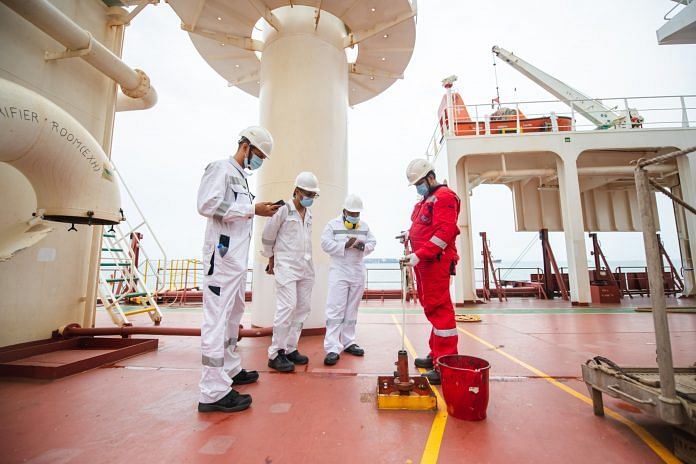Singapore: Ravi Nagar hasn’t seen his wife and 3-year-old son in eight months. That’s because he was stuck on a tanker shuttling between the Middle East and Asia.
Nagar was among the roughly 200,000 seafarers stranded on ships because of tight port restrictions and canceled flights due to Covid-19. But the 40-year-old captain is lucky. On Friday, he disembarked from The Chief in Singapore and headed directly to the airport, wrapped head-to-toe in protective gear.
“Everybody is struggling at this moment,” he said in an interview Friday at the airport before boarding a flight to Mumbai. “I want my son to hug me.”
While some hubs like Singapore and Hong Kong are easing restrictions to help seafarers like Nagar get back to their families, most crews remain stranded on ships at increasing risk of mental and physical fatigue. The captain said he has more than a hundred friends stuck on vessels who don’t know when they will be able to return home.
Singapore’s first crew change under eased restrictions took place June 6, when the Genco Liberty, which was carrying iron ore from Brazil to China, diverted from its course for about 48 hours to stop at the island nation and discharge 19 Indian nationals. Nagar’s ship was the second to change a crew after the port eased virus precautions for seafarers.
“Anyone in shipping, whether it’s on the tanker side, or the container ships side, the gas side, or even cruise ships” faces difficulty in relieving crews, Genco Shipping & Trading Ltd. Chief Executive Officer John Wobensmith said last week. The dry bulk shipper still has “quite a few” seafarers on ships who have worked past their contracts, he said on Bloomberg TV.
Prior to boarding the The Chief, incoming crew self-isolated for 14 days and checked their temperatures twice daily. They were tested for the coronavirus about two days prior to departure and took a flight from Mumbai to Singapore before heading directly to the ship, according to Executive Ship Management, which orchestrated the crew changeover.
Normally, about 100,000 seafarers change vessels every month during scheduled port stops, when vessels discharge and pick up cargo. The longest seafarers should be on board a ship is 11 months, according to the Maritime Labor Convention.
Hong Kong will no longer require compulsory quarantines for visiting cargo ship crews but seafarers must keep a log of their temperature twice a day and wear a face mask during work, according to a notice from the city’s Centre for Health Protection last week.
For vessels without cargo operations entering Hong Kong for crew changes, out-going seafarers who have completed their service are required to stay on the vessel until they can travel directly to the airport for repatriation. In-coming crew should only arrive in Hong Kong once their vessels are berthed and board immediately upon arrival.
“Whilst we welcome a recent increase in the number of crew changes taking places in several jurisdictions, including Hong Kong and Singapore, the sheer scale of crew required to be changed here and now is enormous – 200,000 on board ships at sea, to be replaced by 200,000 ashore,” International Chamber of Shipping Chairman Esben Poulsson said in an email. “The political will to make these crew changes happen, on a government by government basis, is what’s needed to avoid any disruptions in the flow of global trade.”-Bloomberg
Also read: Singapore set to shop and dine as most activities resume Friday






